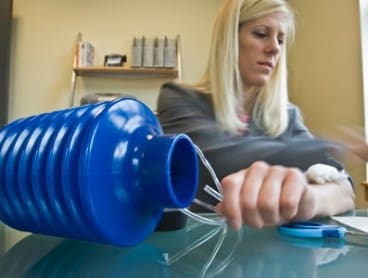Applying negative pressure or suction to a wound promotes healing by keeping fluid from building up in the wound. A few years ago students in an MIT mechanical engineering class decided to work on a pump to provide suction for wounds. With the help of Dr. Robert Sheridan from Massachusetts General Hospital, the students developed a simple, inexpensive, and lightweight version of the system that required no power supply and could be left in place for days. Danielle Zurovcik SM ’07, was one of those students and not only continued to refine the technology in her master’s thesis but plans make it the subject of her doctoral studies as well.
The pump now has some real world experience thanks to Zurovcik providing 50 of the $3 pumps to Partners in Health for use in the Haitian relief effort. The Partners in Health team was led by led by Dr. Robert Riviello of the Division of Trauma, Burn and Surgical Critical Care at Brigham and Women’s Hospital in Boston. “Our biggest challenge at the moment is ensuring a reliably intact seal on human skin [that can be] easily applied,” Riviello says. “If we can resolve this, then I think there is enormous potential.” There is a new, more compact version of the device in production and Zurovcik plans on further studies in Rwanda later this year.
While the technology is available today in any western care facility, it is expensive, relying on shore power or frequent battery changes. This pump is power-free. It’s one step up from ditch medicine and that’s simply because it’s a purpose built solution, but it remains inexpensive and easy to apply. The new MIT pump offers many advantages for military or wilderness use. With suction applied, dressing can be kept in place longer; in some cases up to three days. This is a boon for situations where supplies or health care professionals are limited.


